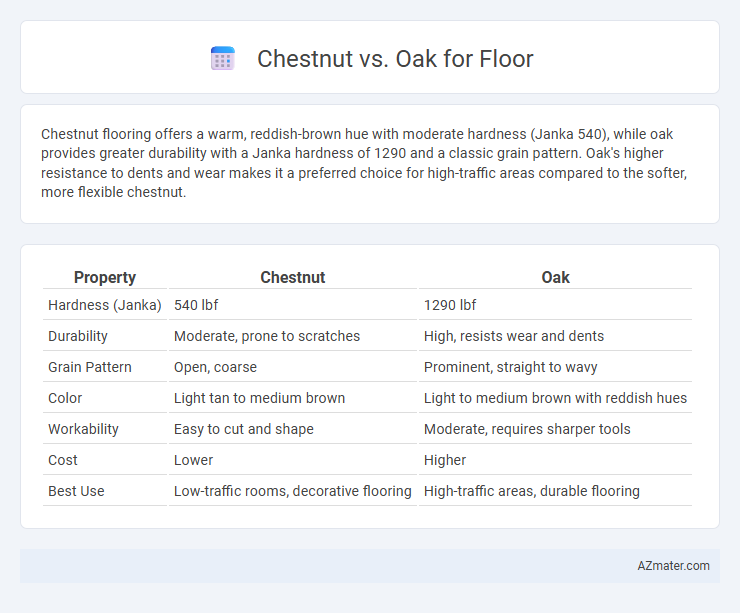Chestnut flooring offers a warm, reddish-brown hue with moderate hardness (Janka 540), while oak provides greater durability with a Janka hardness of 1290 and a classic grain pattern. Oak's higher resistance to dents and wear makes it a preferred choice for high-traffic areas compared to the softer, more flexible chestnut.
Table of Comparison
| Property | Chestnut | Oak |
|---|---|---|
| Hardness (Janka) | 540 lbf | 1290 lbf |
| Durability | Moderate, prone to scratches | High, resists wear and dents |
| Grain Pattern | Open, coarse | Prominent, straight to wavy |
| Color | Light tan to medium brown | Light to medium brown with reddish hues |
| Workability | Easy to cut and shape | Moderate, requires sharper tools |
| Cost | Lower | Higher |
| Best Use | Low-traffic rooms, decorative flooring | High-traffic areas, durable flooring |
Introduction to Chestnut and Oak Flooring
Chestnut flooring offers a warm, rich hue with distinctive grain patterns that bring natural elegance and durability to interiors, making it a popular choice for traditional and rustic designs. Oak flooring, renowned for its hardness and resistance to wear, features a versatile grain texture and light to medium tones, suited for both classic and contemporary spaces. Both hardwoods provide long-lasting performance, with chestnut emphasizing historical charm and oak delivering proven strength and wide availability.
Key Characteristics of Chestnut Flooring
Chestnut flooring is renowned for its rich, warm tones and distinctive grain patterns that add natural character to any space. Its hardness rating on the Janka scale ranges from 900 to 1,200, offering moderate durability suitable for residential use but less resistant to heavy commercial traffic compared to oak. Chestnut's resistance to wear and moderate density makes it an excellent choice for areas requiring both aesthetic appeal and functional performance.
Unique Qualities of Oak Flooring
Oak flooring boasts exceptional durability and rich grain patterns that enhance any interior, making it a preferred choice over chestnut. Its natural resistance to wear and moisture ensures long-lasting performance in high-traffic areas. The warm tones and versatility of oak also provide greater design flexibility compared to the more uniform appearance of chestnut flooring.
Durability: Chestnut vs Oak
Oak flooring is renowned for its exceptional durability, with a Janka hardness rating of approximately 1,290 for red oak and 1,360 for white oak, making it highly resistant to dents and wear. Chestnut, while attractive and historically used, has a lower hardness rating around 600 to 800 on the Janka scale, indicating it is softer and more prone to scratches and dents compared to oak. For high-traffic areas requiring long-lasting performance, oak remains the superior choice due to its robust hardness and resistance to damage.
Appearance and Grain Patterns
Chestnut flooring features a warm, rich color with prominent, linear grain patterns that create a natural, rustic look appealing for traditional and country-style interiors. Oak flooring offers a wider color range from light to medium brown and is characterized by its varied grain patterns, including straight, wavy, and swirled lines that provide a classic and versatile aesthetic suitable for many design styles. The distinct grain of chestnut tends to be more uniform and bold, while oak's grain complexity adds visual depth and texture to flooring surfaces.
Cost Comparison: Chestnut vs Oak
Chestnut flooring typically costs between $4 to $7 per square foot, making it a more affordable option compared to oak, which ranges from $5 to $10 per square foot depending on grade and finish. Installation costs are generally similar for both woods, but chestnut's lower material price can reduce overall expenses for large projects. While chestnut offers cost savings upfront, oak's widespread availability and durability might present better long-term value for some homeowners.
Installation Process and Considerations
Chestnut flooring requires careful acclimation due to its higher moisture content compared to oak, ensuring dimensional stability during installation. Oak offers greater hardness and uniformity, allowing for easier nailing and less anticipation of warping, which streamlines the installation process. Both woods benefit from proper subfloor preparation and moisture barriers, but chestnut demands more attention to humidity control to prevent future gaps or cupping.
Maintenance and Longevity
Chestnut flooring offers moderate maintenance due to its natural resistance to decay and insect damage, making it a durable choice that can last over 50 years with proper care. Oak floors, known for their hardness and density, require regular sealing and refinishing to maintain their appearance but typically provide superior longevity, often exceeding 75 years. Both hardwoods benefit from routine cleaning and protection against moisture to preserve their structural integrity and aesthetic appeal.
Environmental Impact and Sustainability
Chestnut flooring offers a lower environmental impact due to its faster growth rates and greater carbon sequestration compared to oak, promoting sustainable forest management. Oak, while slower-growing, is highly durable and often sourced from responsibly managed forests certified by organizations like FSC, ensuring long-term ecosystem balance. Both woods provide renewable options, but chestnut's quicker renewability can result in a smaller carbon footprint over time.
Which is Best? Choosing Between Chestnut and Oak Floors
Oak floors offer superior durability and hardness, making them ideal for high-traffic areas and long-term investment in flooring. Chestnut provides a distinctive warm tone and natural resistance to insect damage, appealing for aesthetic focus and moderate wear environments. Selecting between chestnut and oak floors depends on prioritizing either robust longevity with oak or unique appearance with chestnut.

Infographic: Chestnut vs Oak for Floor
 azmater.com
azmater.com